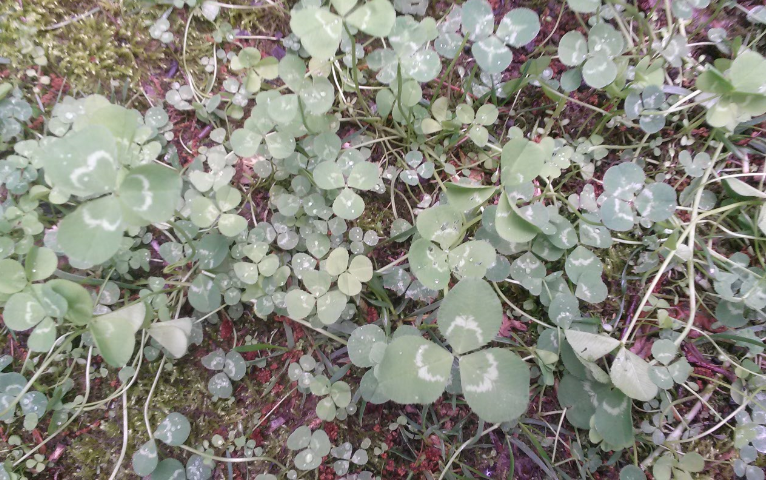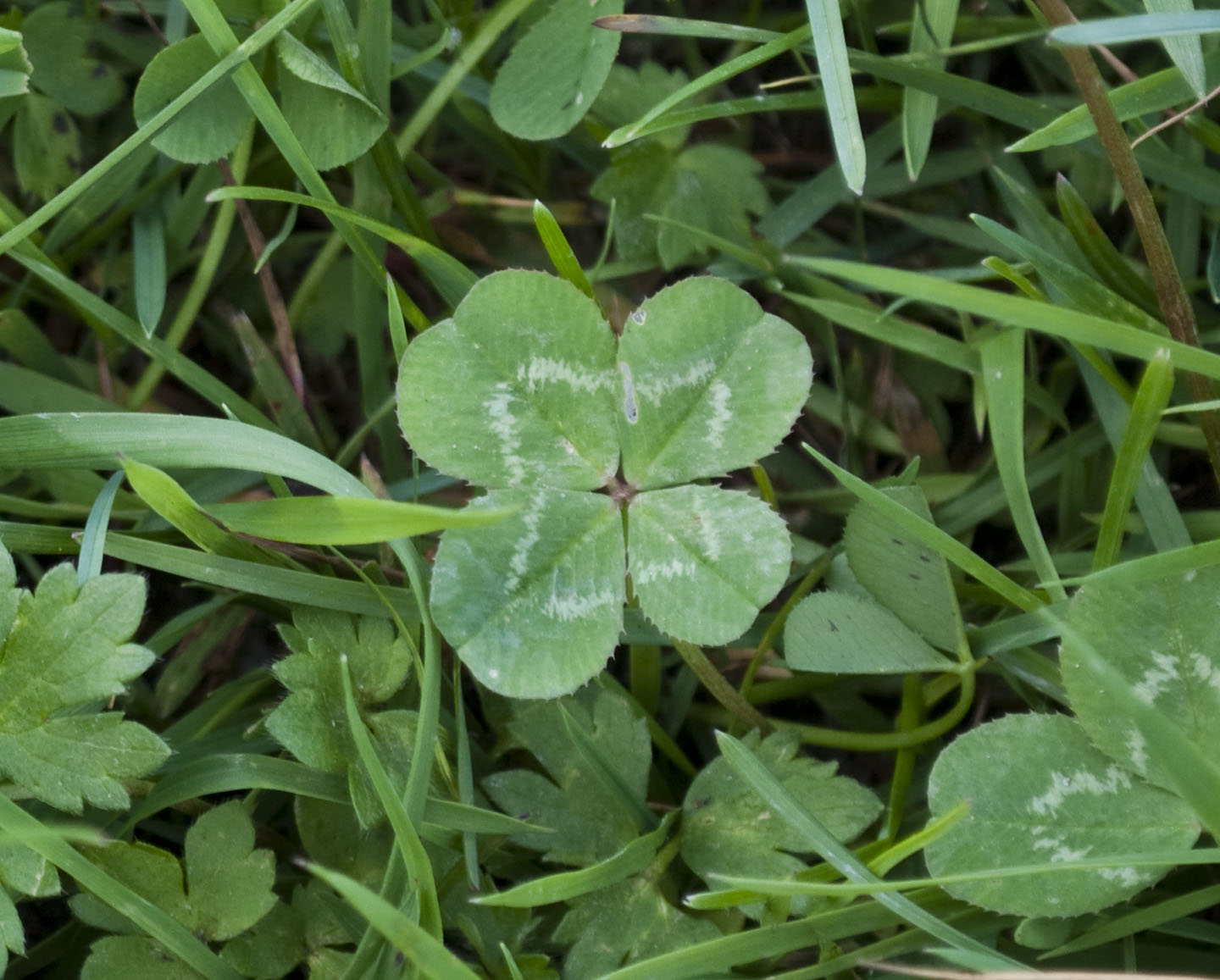|
Clover
Clovers, also called trefoils, are plants of the genus ''Trifolium'' (), consisting of about 300 species of flowering plants in the legume family Fabaceae originating in Europe. The genus has a cosmopolitan distribution with the highest diversity in the temperate Northern Hemisphere, but many species also occur in South America and Africa, including at high altitudes on mountains in the tropics. They are small annual, biennial, or short-lived perennial herbaceous plants, typically growing up to tall. The leaves are trifoliate (rarely, they have more or fewer than three leaflets; the more (or fewer) leaflets the leaf has, the rarer it is; see four-leaf clover), with stipules adnate to the leaf-stalk, and heads or dense spikes of small red, purple, white, or yellow flowers; the small, few-seeded pods are enclosed in the calyx. Other closely related genera often called clovers include '' Melilotus'' (sweet clover) and '' Medicago'' (alfalfa or Calvary clover). As legume ... [...More Info...] [...Related Items...] OR: [Wikipedia] [Google] [Baidu] [Amazon] |
Trifolium Sect
Clovers, also called trefoils, are plants of the genus ''Trifolium'' (), consisting of about 300 species of flowering plants in the legume family Fabaceae originating in Europe. The genus has a cosmopolitan distribution with the highest diversity in the temperate Northern Hemisphere, but many species also occur in South America and Africa, including at high altitudes on mountains in the tropics. They are small annual, biennial, or short-lived perennial herbaceous plants, typically growing up to tall. The leaves are trifoliate (rarely, they have more or fewer than three leaflets; the more (or fewer) leaflets the leaf has, the rarer it is; see four-leaf clover), with stipules adnate to the leaf-stalk, and heads or dense spikes of small red, purple, white, or yellow flowers; the small, few-seeded pods are enclosed in the calyx. Other closely related genera often called clovers include ''Melilotus'' (sweet clover) and ''Medicago'' (alfalfa or Calvary clover). As legumes, clove ... [...More Info...] [...Related Items...] OR: [Wikipedia] [Google] [Baidu] [Amazon] |
Four-leaf Clover
The four-leaf clover is a rare mutation of the common three-leaf clover that has four Leaflet (botany), leaflets instead of three. According to traditional sayings, such clovers bring good luck, a belief that dates back to at least the 17th century. The term ''four-leaf'' is Botany, botanically a misnomer, as Clover, cloverplants have multiple leaves (multiple clovers), each consisting of a varying number of Leaflet (botany), leaflets, typically three. Occurrence A 2017 survey of approximately 5.7 million clovers in six European countries found the frequency of 4-leaf clovers to be around 5000 to 1 (one 4-leaf clover for every 5076 normal 3-leaf clovers), almost twice the commonly stated probability of 10,000 to 1. According to this survey, the frequency of a 5-leaf clover is 24,390 to 1, and that of a 6-leaf clover is 312,500 to 1. According to Guinness World Records, the clover with the most leaflets ever found had 63 of them, and was discovered by Yoshiharu Watanabe of Nas ... [...More Info...] [...Related Items...] OR: [Wikipedia] [Google] [Baidu] [Amazon] |
Melilotus
''Melilotus'', known as melilot or sweet clover is a genus of legumes in the family Fabaceae, native to Europe, Asia, and Africa. The genus is closely related to ''Trifolium'' (clovers). Several species are common grassland plants and weeds of cultivated ground, and some species are now found worldwide as naturalised plants. The scientific and English names both derive from Greek ''melílōtos'' from ''méli'' (honey), and ''lōtos'' ( lotus), via Latin ''melilōtos'' and Old French ''mélilot''. The alternative name "sweet clover" varies in orthography, also cited as sweet-clover and sweetclover. Other names include "kumoniga", from the Cumans.Bulgarian Folk Customs, Mercia MacDermott, pg 27 Description The species are annual, biennial, or perennial herbaceous plants, growing to 50–150 cm tall, with trifoliate leaves similar to clover but narrower, the leaflets only about half as wide as long, and with a serrated margin; each leaf also has two small basal stipules. The flow ... [...More Info...] [...Related Items...] OR: [Wikipedia] [Google] [Baidu] [Amazon] |
Legume
Legumes are plants in the pea family Fabaceae (or Leguminosae), or the fruit or seeds of such plants. When used as a dry grain for human consumption, the seeds are also called pulses. Legumes are grown agriculturally, primarily for human consumption, but also as livestock forage and silage, and as soil-enhancing green manure. Legumes produce a botanically unique type of fruit – a simple fruit, simple Dry fruits, dry fruit that develops from a simple carpel and usually Dehiscence (botany) , dehisces (opens along a seam) on two sides. Most legumes have Symbiosis , symbiotic nitrogen fixation , nitrogen-fixing bacteria, Rhizobia, in structures called root nodules. Some of the fixed nitrogen becomes available to later crops, so legumes play a key role in crop rotation. Terminology The term ''pulse'', as used by the United Nations' Food and Agriculture Organization (FAO), is reserved for legume crops harvested solely for the dry seed. This excludes green beans and Pea , green ... [...More Info...] [...Related Items...] OR: [Wikipedia] [Google] [Baidu] [Amazon] |
Fabaceae
Fabaceae () or Leguminosae,International Code of Nomenclature for algae, fungi, and plants. Article 18.5 states: "The following names, of long usage, are treated as validly published: ....Leguminosae (nom. alt.: Fabaceae; type: Faba Mill. Vicia L.; ... When the Papilionaceae are regarded as a family distinct from the remainder of the Leguminosae, the name Papilionaceae is conserved against Leguminosae." English pronunciations are as follows: , and . commonly known as the legume, pea, or bean family, is a large and agriculturally important family of |
Leaves
A leaf (: leaves) is a principal appendage of the stem of a vascular plant, usually borne laterally above ground and specialized for photosynthesis. Leaves are collectively called foliage, as in "autumn foliage", while the leaves, stem, flower, and fruit collectively form the shoot system. In most leaves, the primary photosynthetic tissue is the palisade mesophyll and is located on the upper side of the blade or lamina of the leaf, but in some species, including the mature foliage of ''Eucalyptus'', palisade mesophyll is present on both sides and the leaves are said to be isobilateral. The leaf is an integral part of the stem system, and most leaves are flattened and have distinct upper ( adaxial) and lower ( abaxial) surfaces that differ in color, hairiness, the number of stomata (pores that intake and output gases), the amount and structure of epicuticular wax, and other features. Leaves are mostly green in color due to the presence of a compound called chlorop ... [...More Info...] [...Related Items...] OR: [Wikipedia] [Google] [Baidu] [Amazon] |
Flowering Plant
Flowering plants are plants that bear flowers and fruits, and form the clade Angiospermae (). The term angiosperm is derived from the Ancient Greek, Greek words (; 'container, vessel') and (; 'seed'), meaning that the seeds are enclosed within a fruit. The group was formerly called Magnoliophyta. Angiosperms are by far the most diverse group of Embryophyte, land plants with 64 Order (biology), orders, 416 Family (biology), families, approximately 13,000 known Genus, genera and 300,000 known species. They include all forbs (flowering plants without a woody Plant stem, stem), grasses and grass-like plants, a vast majority of broad-leaved trees, shrubs and vines, and most aquatic plants. Angiosperms are distinguished from the other major seed plant clade, the gymnosperms, by having flowers, xylem consisting of vessel elements instead of tracheids, endosperm within their seeds, and fruits that completely envelop the seeds. The ancestors of flowering plants diverged from the commo ... [...More Info...] [...Related Items...] OR: [Wikipedia] [Google] [Baidu] [Amazon] |
Perennial Plant
In horticulture, the term perennial (''wikt:per-#Prefix, per-'' + ''wikt:-ennial#Suffix, -ennial'', "through the year") is used to differentiate a plant from shorter-lived annual plant, annuals and biennial plant, biennials. It has thus been defined as a plant that lives more than 2 years. The term is also loosely used to distinguish plants with little or no woody growth (secondary growth in Tree girth measurement, girth) from trees and shrubs, which are also technically ''perennials''. Notably, it is estimated that 94% of plant species fall under the category of perennials, underscoring the prevalence of plants with lifespans exceeding two years in the botanical world. Perennials (especially small flowering plants) that grow and bloom over the spring and summer, die back every autumn and winter, and then return in the spring from their rootstock or other overwintering structure, are known as Herbaceous plant, herbaceous perennials. However, depending on the rigours of the loca ... [...More Info...] [...Related Items...] OR: [Wikipedia] [Google] [Baidu] [Amazon] |
Annual Plant
An annual plant is a plant that completes its life cycle, from germination to the production of seeds, within one growing season, and then dies. Globally, 6% of all plant species and 15% of herbaceous plants (excluding trees and shrubs) are annuals. The annual life cycle has independently emerged in over 120 different plant families throughout the entire angiosperm phylogeny. The evolutionary and ecological drivers of the annual life cycle Traditionally, there has been a prevailing assumption that annuals have evolved from perennial ancestors. However, recent research challenges this notion, revealing instances where perennials have evolved from annual ancestors. Intriguingly, models propose that transition rates from an annual to a perennial life cycle are twice as fast as the reverse transition. The life-history theory posits that annual plants are favored when adult mortality is higher than seedling (or seed) mortality, i.e., annuals will dominate environments with dis ... [...More Info...] [...Related Items...] OR: [Wikipedia] [Google] [Baidu] [Amazon] |






